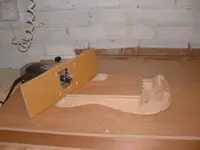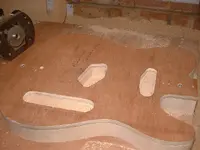Chili
Site Moderator
Cool. Something like that looks super easy to build.
I like the pencil trick.
I like the pencil trick.
Here's a simple router jig for planing.
Thanks for the sled idea mutty. can i use MDF or should i just be using hardwood for a base.



Muttley, how high are the sides on that sled? It looks very simple to build so I think I make one so I can be ready when and if you start that build thread you talked about earlier.
Thanks Muttley. After looking at this I remembered that JCH had pics of his router sled and he has it rigged so that what he is routing can be raised or lowered. I'd be a little concerned that putting pressure on what you are routing could cause it to fall, but I'm sure he probably has some type of fail-safe to prevent that from happening.

I think you missed the point. You don't need a surface planer, or jointer to build a guitar. You need a router though.Glen said:What you need most of all is a solid workbench.
Thanks Glen for the honest disclosure. I realize that joiners, plainers, Oscillating Spindle Sanders, drill presses, etc all make guitar builder eaiser and perhaps better quality. I need to work with what i can afford and i've seen good results on youtube and guitar making forums. hopefully i can maximize my results with help from my friends.
I will take the work bench comment to heart. definitely need to make a solid work bench priority.
Looking at this work bench plan now:
Free Woodworking Plans from Getting Started in Woodworking - Fine Woodworking Article
I think i will be going the router sled route (no pun intended)
It may have been well intentioned but it is wrong. ..
Bull S%$t Muttley. You have just forgotten how important they are because you have access to them. Get rid of your work bench and your joining tools and then let's see how your projects come out. The router wasn't even invented until 1950 or so. Lots of other ways to shape wood, but your workbench and joining tools are vital.

Let's not allow a simple disagreement distract this thread, please.
